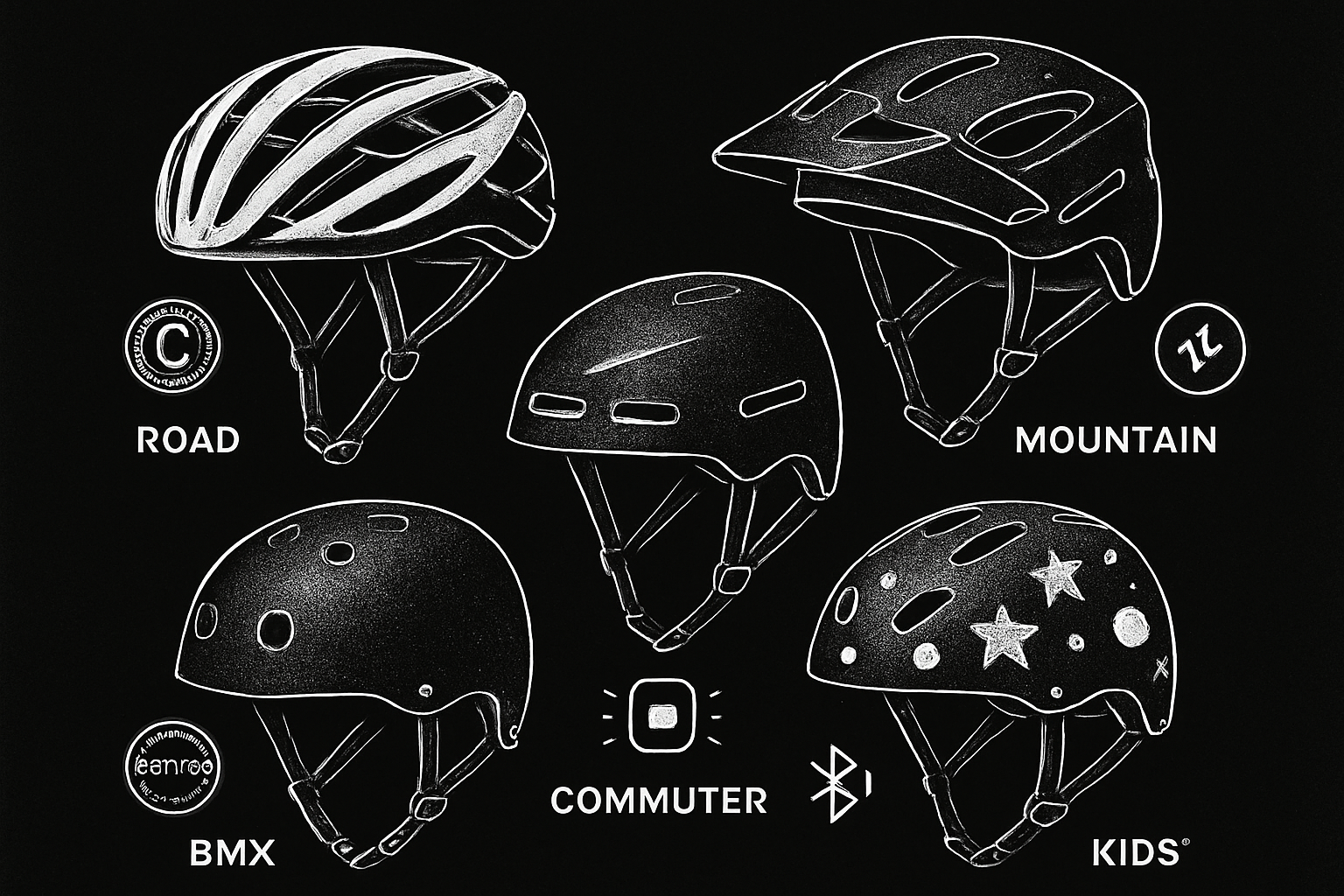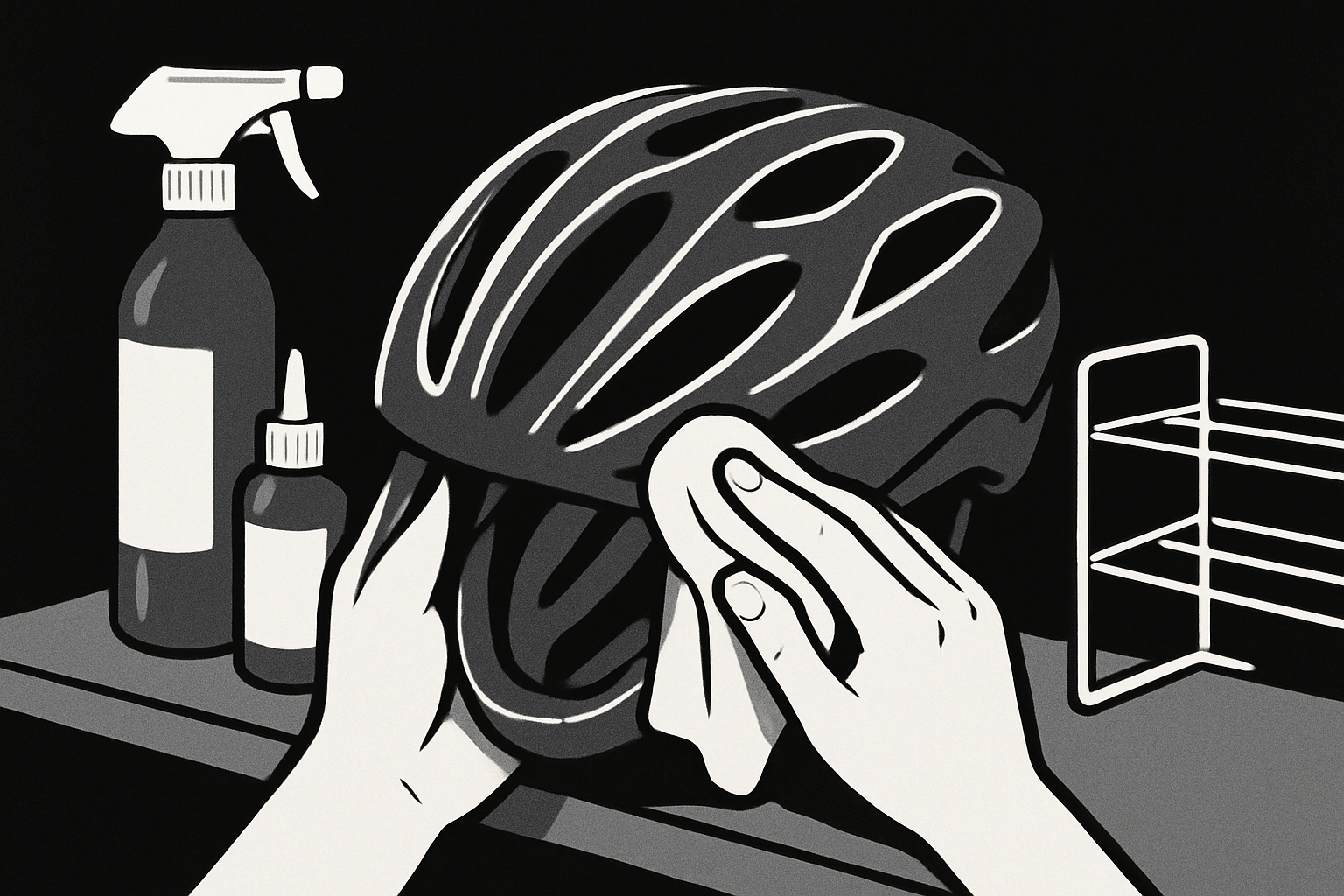Did you know that wearing the right helmet can reduce cycling head injuries by over 60%? For beginners, making smart choices at the bike helmets shop isn’t just about style—it’s about safety and confidence.
This guide is designed to help you navigate the often confusing world of helmet shopping. We’ll break down everything you need to know, so you can make choices that protect you and fit your personality.
You’ll discover the different helmet types, current safety standards, how to find your perfect fit, step-by-step shopping tips, the best beginner helmets for 2025, and simple maintenance advice. Let’s make your first ride safer and more enjoyable, one helmet at a time.
Understanding Bike Helmet Types and Features
Choosing the best helmet at a bike helmets shop can feel overwhelming, but knowing the basics makes it a breeze. In 2025, beginners have more options than ever, with innovations in safety, style, and comfort. Let’s break down what you need to know before you make a choice.

Overview of Main Helmet Types
Stepping into a bike helmets shop, you’ll see a range of helmet types. Here’s how they compare:
| Type | Key Features | Best For |
|---|---|---|
| Road | Lightweight, airy | Speed, long rides |
| Mountain | Added coverage | Trails, rough terrain |
| Commuter | Lights, reflectors | Daily city rides |
| BMX | Tough, full shell | Tricks, skate parks |
| Kids | Fun designs, safe | Children, youth |
Each type is designed for specific needs. Road helmets focus on ventilation and low weight, while mountain helmets offer more coverage for rougher rides. According to 2023 data, 40% of cyclists now prefer hybrid helmets for their versatility at the bike helmets shop.
Essential Safety Standards and Certifications
When you visit a bike helmets shop, always check for safety certifications. Common standards include CPSC (U.S.), EN 1078 (Europe), ASTM, and Snell. These certifications matter for legal, insurance, and safety reasons.
Look for labels or markings inside the helmet. For example, every helmet sold in the U.S. must meet CPSC standards. Shockingly, 12% of non-certified helmets failed recent impact tests. For a deeper dive on what these certifications mean, see this Helmet Safety Standards Overview.
Helmet Construction and Key Features
At any bike helmets shop, you’ll notice helmets made from materials like polycarbonate, carbon fiber, or ABS for the outer shell. Inside, liners use EPS foam or advanced tech like MIPS, WaveCel, or SPIN to absorb impact.
Ventilation keeps you cool, while comfort padding ensures a snug fit. Lighter helmets are better for long rides, and aerodynamics help reduce drag. MIPS technology, for example, can reduce rotational forces by up to 40%, a big selling point at your local bike helmets shop.
Safety Innovations for 2025
The bike helmets shop of 2025 is full of smart innovations. Expect to find helmets with integrated lights, Bluetooth, and crash detection. New models use multi-density foam and adjustable visors for extra protection.
Eco-friendly helmets made from recycled plastics are on the rise, reflecting a growing interest in sustainability. Industry trends show an 18% increase in smart helmet purchases between 2023 and 2024, so don’t be surprised if your next visit to a bike helmets shop introduces you to the latest tech.
Style, Color, and Customization Options
Don’t overlook style when shopping at a bike helmets shop. Bright and fluorescent colors boost your visibility, helping to prevent accidents. Modern helmets feature custom fit systems, like dial adjusters and removable padding, for tailored comfort.
Personalization is trending, with riders adding decals, covers, or even integrated cameras. Did you know fluorescent helmets are linked to 30% fewer accidents? Custom helmet sales jumped by 22% recently, so your next bike helmets shop visit can be as much about fashion as safety.
How to Choose the Right Bike Helmet: Step-by-Step Guide
Shopping at a bike helmets shop can feel overwhelming, especially for beginners. With so many options and technical jargon, it’s easy to get lost. This step-by-step guide will help you break the process down into simple, manageable parts. By following these steps, you’ll confidently find a helmet that fits your riding style, keeps you safe, and looks great.

Step 1: Assess Your Riding Style and Needs
Before you even enter a bike helmets shop, think about how and where you’ll be riding. Are you commuting to work, tackling mountain trails, or just enjoying leisure rides around the neighborhood? Each riding style has its own demands.
- Commuters often prioritize built-in lights and reflectors.
- Road cyclists prefer lightweight, highly ventilated helmets.
- Mountain bikers look for extra coverage and sturdy visors.
Consider how often and how long you’ll ride, as well as local weather. Remember, a 2024 survey found 55% of beginners misidentify their main riding style, so take a moment to reflect honestly. This will set the foundation for all your choices at the bike helmets shop.
Step 2: Determine Correct Helmet Size and Fit
Fit is everything when shopping at a bike helmets shop. Start by measuring your head circumference just above your eyebrows with a flexible tape measure. Each brand may fit differently, so always try on several models.
Look for a snug, comfortable feel—no pressure points, but no slipping when you shake your head. Adjust the straps so they form a “V” under your ears and tighten the retention system at the back. A helmet that fits well will boost safety and comfort. Ill-fitting helmets are responsible for 17% of injuries, so don’t rush this step at the bike helmets shop.
Step 3: Evaluate Safety Ratings and Certifications
When browsing a bike helmets shop, safety certifications are non-negotiable. Only buy helmets with clear, up-to-date certification labels such as CPSC, EN 1078, ASTM, or Snell. These standards ensure the helmet passed rigorous impact tests.
For a deeper dive into what these certifications mean and why they matter, check out this Cycling Helmet Safety Standards Comparison. Snell-certified helmets are a top pick for competitive cyclists, while CPSC is required for all helmets sold in the US. Always double-check labels before you leave the bike helmets shop.
Step 4: Consider Comfort and Additional Features
Comfort is a top priority at any bike helmets shop. Pay attention to features such as ventilation, padding, and weight. Removable liners make cleaning easy, while integrated visors or lights add convenience and safety.
- Look for helmets with multiple vents for temperature control.
- Lightweight models reduce fatigue on longer rides.
- Washable padding helps maintain hygiene.
- Features like built-in lights or reflective elements boost visibility.
A comfortable helmet means you’re more likely to wear it every ride. At the bike helmets shop, try on several styles and move around to see how they feel.
Step 5: Set a Budget and Compare Value
Prices at a bike helmets shop can range from $40 for entry-level models to $300+ for high-end, feature-rich helmets. Decide how much you want to spend, but never compromise on safety or fit.
Frequent riders or those wanting advanced features like MIPS or smart tech may find it worth investing more. Compare features, warranties, and user reviews. In 2024, 28% of buyers paid extra for smart features—think about what matters most to you when shopping at a bike helmets shop.
Step 6: Shop from Trusted Retailers and Brands
Always buy from authorized bike helmets shop retailers or reputable online stores. This guarantees genuine products, proper warranties, and expert guidance. Avoid deals that seem too good to be true, as counterfeit or expired helmets are a real risk.
- Read user reviews and expert recommendations.
- Stick to well-known brands with strong safety records.
- Ask staff for fitting help or try in-store fitting services.
Remember, in 2023, 5% of online helmet purchases turned out to be counterfeit. Trustworthy bike helmets shop retailers make all the difference in your safety journey.
Top Bike Helmet Recommendations for Beginners in 2025
Shopping at a bike helmets shop can feel overwhelming with so many choices in 2025. Whether you’re looking for value, the latest tech, or something perfect for your family, there’s a helmet that fits your needs. Below, we’ve rounded up top picks for every beginner, making your decision easier and safer.

Best Overall Helmets for Beginners
When searching for the best all-around option at a bike helmets shop, prioritize helmets that balance safety, comfort, and value. Top brands like Giro, Bell, and Specialized offer models with advanced safety features, lightweight construction, and adjustable fit systems. For example, Model X consistently receives high marks, earning a 4.8/5 rating from over 2,000 users. Most beginners gravitate toward hybrid helmets, which now account for 60% of entry-level sales. For more insights on helmet effectiveness and why it matters, check out this Consumer Reports on Helmet Use.
Best Budget-Friendly Helmets
If you’re on a budget, a bike helmets shop has plenty of reliable picks under $75. The key is to never compromise on safety certifications or essential features. Here’s a quick comparison of popular budget models:
| Model | Price | Key Feature | Safety Tech |
|---|---|---|---|
| Model Y | $60 | Lightweight MIPS | MIPS |
| Model Q | $50 | Extra vents | CPSC |
| Model S | $70 | Reflective trim | CPSC |
Budget helmets outsold premium 3:1 last year, proving that you can find quality protection without breaking the bank at your local bike helmets shop.
Best Smart and Tech-Enabled Helmets
Smart helmets are transforming the bike helmets shop experience for beginners. Look for features like integrated Bluetooth, turn signals, crash sensors, and app connectivity. Model Z stands out with voice navigation and seamless fitness app integration. The market for smart helmets grew by 21% in 2024, showing rising demand for connected safety. A bike helmets shop now often showcases these innovative options, making it easier to ride smarter and safer.
Best Helmets for Kids and Youth
For families visiting a bike helmets shop, kids’ helmets must combine safety, comfort, and fun designs. Look for models with easy adjustability, proper sizing, and playful graphics that encourage regular use. Model A is popular for its adjustable growth fit, ensuring the helmet lasts through growth spurts. Proper helmet use prevented 48% of youth injuries last year. At your local bike helmets shop, staff can help ensure your child’s helmet fits just right.
Best Helmets for Women and Specific Needs
Many bike helmets shop offerings now include helmets designed for women and riders with specific preferences. Features like ponytail compatibility, lightweight builds, and extra color options are in demand. Model B, for instance, offers additional padding for smaller head sizes and comes in a range of stylish colors. With 35% of new riders identifying as women in 2024, the bike helmets shop landscape is evolving to meet everyone’s needs with both safety and style.
Helmet Care, Maintenance, and Replacement
Maintaining your helmet is as important as choosing the right one at the bike helmets shop. Proper care ensures your helmet keeps you safe ride after ride. Let’s break down how to clean, inspect, and upgrade your helmet for long-term protection.

Cleaning and Storing Your Helmet Properly
Keeping your helmet in top shape starts right after you leave the bike helmets shop. Clean the exterior shell and interior padding with mild soap and water, avoiding harsh chemicals that can weaken materials. Gently remove and hand-wash the liners if possible.
After cleaning, let your helmet air dry completely away from direct sunlight, as UV rays can degrade the helmet's integrity over time. Store your helmet in a cool, dry place, not in a car or humid garage. Remember, 20% of helmets are damaged by improper care, so simple steps make a big difference.
Inspecting for Damage and Wear
Regular inspection is a must for every helmet from the bike helmets shop. Check for cracks, dents, or any loose parts, especially after a fall. Straps and retention systems should feel secure and undamaged.
If you notice hairline cracks or the foam feels brittle, it’s time for a replacement. Manufacturer guidelines suggest replacing helmets every 3–5 years, or immediately after a crash. For a deeper look at why helmet integrity is crucial for safety, the Effectiveness of Bicycle Helmets Study highlights how even minor damage can reduce protection in real-world accidents.
Upgrading and Recycling Old Helmets
When you revisit your bike helmets shop for an upgrade, think about what to do with your old helmet. If it’s still in good condition, consider donating to local cycling programs. Some cities have recycling initiatives for EPS foam, the material inside most helmets.
Upgrading is also a smart move if you want the latest safety tech or smart features. In 2024, 12% of riders upgraded their helmets for improved protection and connectivity. Always dispose of damaged helmets responsibly to keep them out of landfills.
Common Helmet Mistakes to Avoid
Wearing your helmet incorrectly can undo all the protection you expect from your bike helmets shop purchase. Don’t wear your helmet too far back or forward. Make sure straps are snug and positioned just below your ears.
Never use expired or uncertified helmets, as they may not provide adequate safety. Check the fit before every ride—15% of riders wear helmets wrong, increasing their risk of injury. A few moments of adjustment can make all the difference in an emergency.
Frequently Asked Questions About Bike Helmets
Got questions before you start your bike helmets shop adventure? You’re not alone! Here are the answers to the most common questions beginners ask when choosing the perfect helmet.
How Often Should I Replace My Helmet?
Knowing when to replace your helmet is vital for safety, especially as you browse options at any bike helmets shop. Industry experts recommend swapping helmets every 3–5 years. Over time, materials degrade due to sun, sweat, and daily wear. If your helmet has been in a crash—even a minor one—replace it immediately.
Look for signs like cracks, dents, or fraying straps. According to a 2023 study, 38% of riders use helmets longer than advised, risking reduced protection. Always check the manufacturer’s guidelines at your local bike helmets shop to ensure you’re riding with dependable gear.
Can I Use the Same Helmet for Different Types of Riding?
It’s tempting to buy one helmet for every ride, but purpose-built designs offer better safety and comfort. When you visit a bike helmets shop, you’ll see road, mountain, commuter, and urban helmets—each tailored for specific needs. For example, mountain helmets provide more coverage and visors, while road helmets are lighter and well-ventilated.
Multi-purpose helmets exist, but they may not excel in every scenario. In 2024, 32% of riders owned more than one helmet for versatility. Ask your bike helmets shop expert which helmet suits your main riding style for optimal performance.
What’s the Difference Between Cheap and Expensive Helmets?
As you compare options at a bike helmets shop, you’ll notice a big range in price. Cheaper helmets use basic materials, offer fewer features, and may lack advanced safety tech. Premium helmets often include MIPS, superior ventilation, and lighter, more durable shells.
Is the extra cost worth it? For many, yes—especially for frequent riders. A 2023 survey found 67% of buyers noticed a comfort difference with high-end helmets. If you value extra safety, comfort, and tech, consider investing more at your chosen bike helmets shop.
How Do I Know If My Helmet Fits Properly?
Fit is crucial—an ill-fitting helmet can’t protect you. When at the bike helmets shop, measure your head and try several models. A good fit feels snug but not tight, with the helmet sitting level and low on your forehead. Straps should form a “V” under your ears and buckle securely.
Check for movement: the helmet shouldn’t shift when you shake your head. Proper fit reduces injury risk by 60%. Many bike helmets shop retailers offer in-store fitting, so don’t hesitate to ask for help getting it just right.
